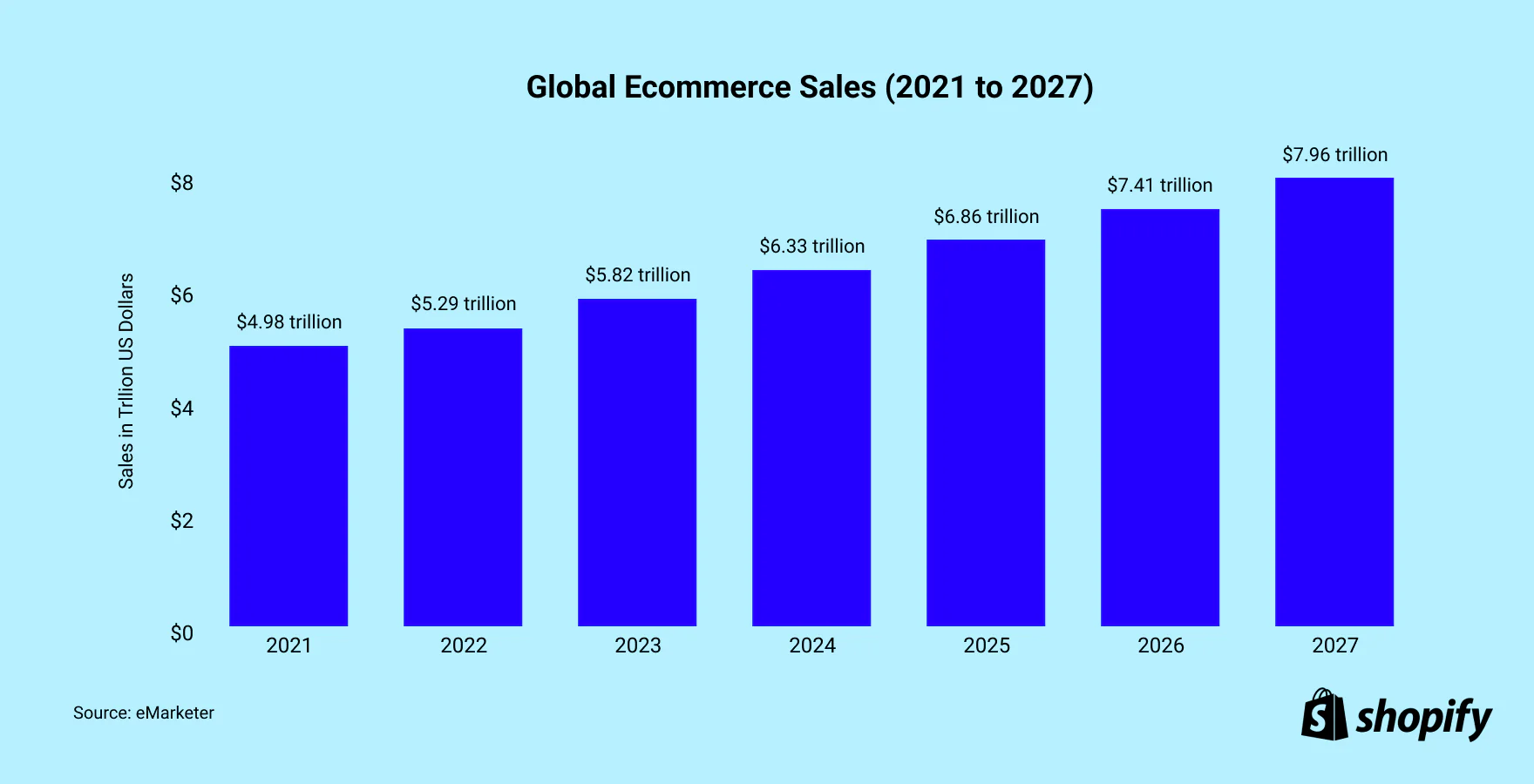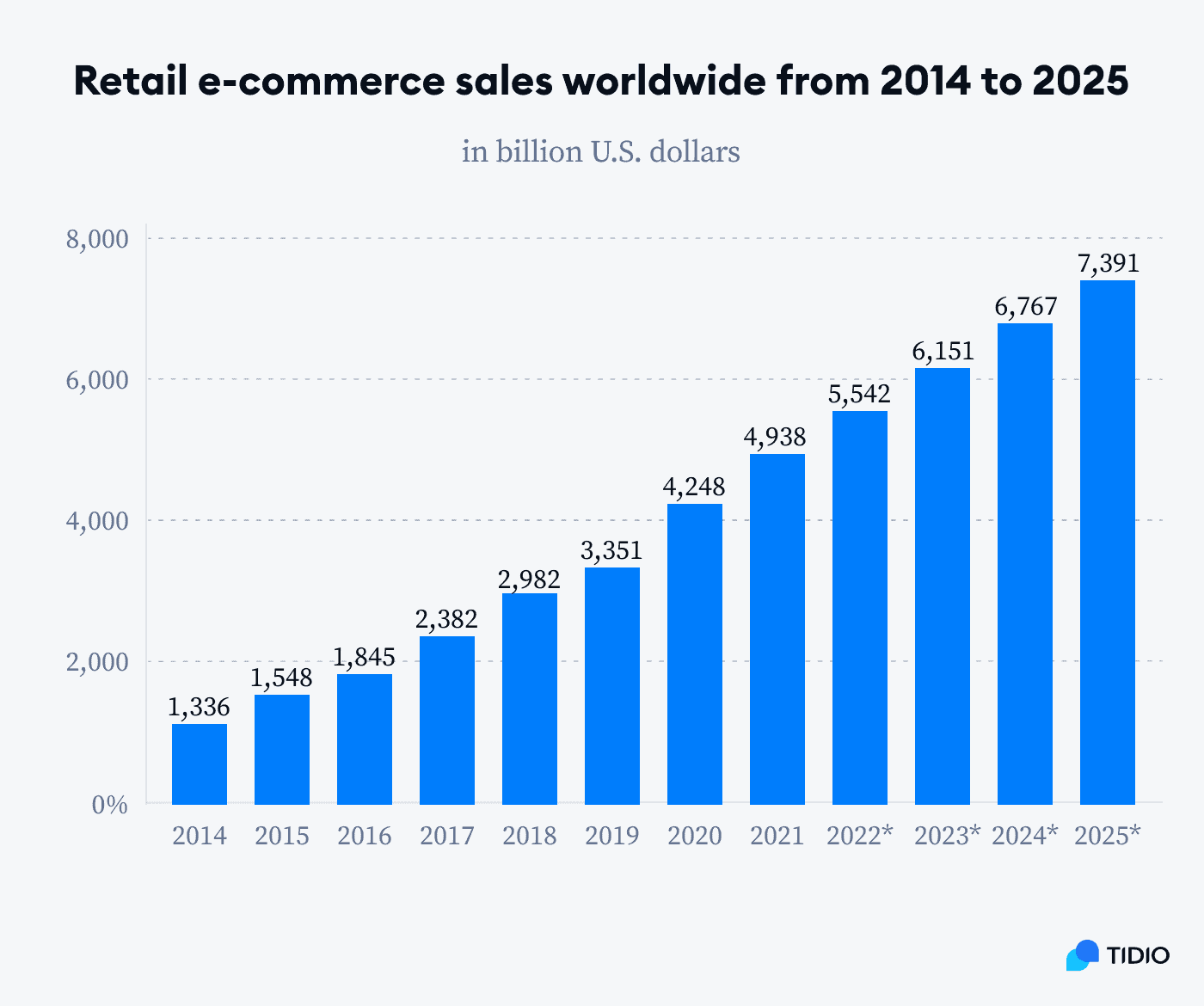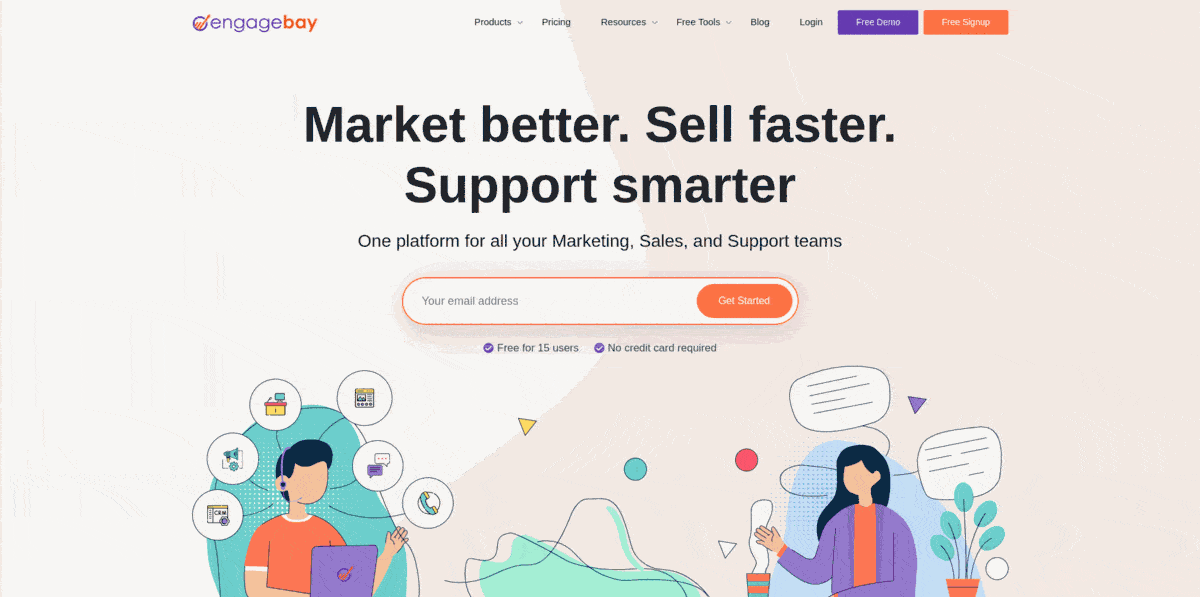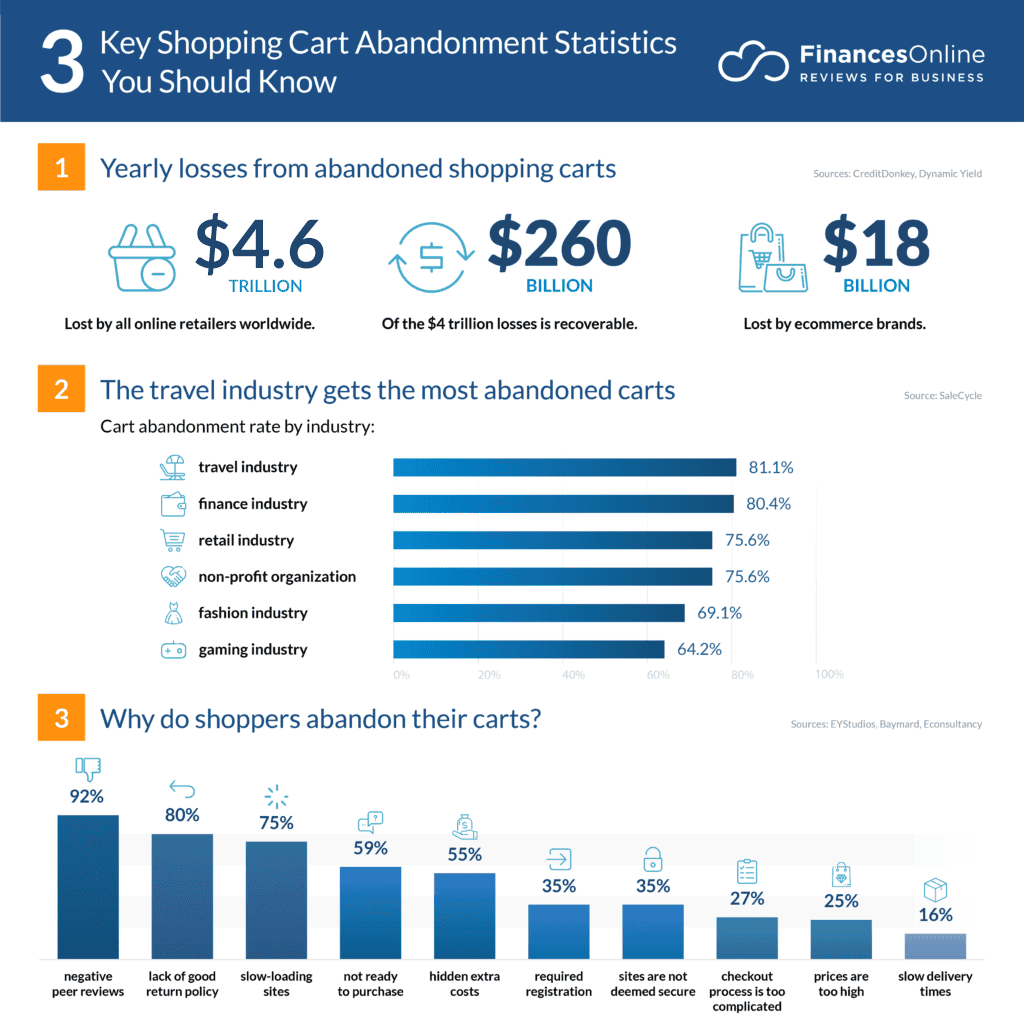eCommerce is on a winning streak. Over two billion people buy things online from social media stores or dedicated eCommerce platforms. Electronic commerce, also known as eCommerce, enables online retailers and eCommerce businesses to sell goods to local and international buyers over the Internet.
According to a Forbes report, the global eCommerce market is expected to be worth $6.3 trillion this year—up from $5.8 trillion in 2023. Additionally, online sales are expected to reach $6.3 billion in 2024 and $7.9 billion in 2027.

So, online businesses are doubling their budgets to promote online stores rather than investing in brick-and-mortar stores. However, the eCommerce rose has its thorns, too. In this blog post, we look at the advantages and disadvantages of the eCommerce business model from the sellers’ perspectives.
In this blog post, we cover the following:
- The advantages and disadvantages of eCommerce
- The types of eCommerce business models
- Expert insight from eCommerce sellers
Table of Contents
eCommerce 101 — Understanding the Basics
eCommerce refers to buying and selling goods over the Internet. It has several advantages over the brick-and-mortar business model. For instance, when doing business online, you are not limited to local consumers; you can reach customers worldwide with your services.
To make the most of this global reach, partnering with an eCommerce website design agency can help you build a professional, user-friendly site that attracts and retains customers.
Buyers can shop from anywhere, anytime, with just a few clicks on your eCommerce website.
eCommerce, however, has evolved from just online sales to involve all aspects of business and market procedures.
Today, transactions of money, funds, and data over the Internet are also considered eCommerce. There are over 26.6 million eCommerce sites worldwide, and one reason they have become so popular is the COVID-19 pandemic.
The pandemic changed consumer behaviors and further pushed the adoption of eCommerce, shifting customer preferences from brick-and-mortar stores to online shopping.
Today, more people shop online rather than in physical stores.
Types of eCommerce models
There are several eCommerce models, although the most popular are business-to-consumer and business-to-business. It is important to examine the different types of eCommerce before we discuss their advantages and disadvantages.
| eCommerce Model | Definition | Examples | Characteristics | Uniqueness |
| Business-to-Consumer (B2C) | Transactions between businesses and end consumers | Amazon, Zara, Apple | Direct selling to consumers focuses on user experience and online marketing, fast purchase decisions | High transaction volumes with lower individual values, consumer-centric marketing strategies |
| Business-to-Business (B2B) | Transaction between businesses | Alibaba, ThomasNet, Office Depot | Larger order quantities, higher volume of transactions, complex purchasing processes, and long-term relationships | Personalized pricing, negotiated deals, and supply chain integration |
| Consumer-to-Consumer (C2C) | eCommerce model for transactions between consumers | eBay, Craiglist, Poshmark | Peer-to-peer selling, second-hand or unique items, relies on user reviews and ratings | Platforms act as intermediaries, critical trust and safety features |
| Consumer-to-Business (C2B) | Transactions where consumers sell to businesses | Shutterstock, Upwork, Google AdSense | Consumers offer products or services to businesses; it can involve digital products and freelance services | It is often project-based or unique transactions; consumers are the ones who set the terms and prices |
| Business-to-Government (B2G) | eCommerce between businesses and government agencies | Government procurement portals, IT vendors for government | Strict regulatory requirements, bidding process, long sales cycles | Highly structured transactions with a focus on transparency and regulations |
| Government-to-Business (G2B) and Government-to-Consumer (G2C) | The government provides services or information to businesses (G2B) or consumers (G2C) | G2B: Business licenses, tax filing systems; G2C: Online tax filing, e-governance services | Efficiency, accessibility, transparency, and use of online platforms | It improves public service delivery, reduces bureaucracy, and increases accessibility |
| Direct-to-Consumer (D2C) | Businesses sell directly to consumers without intermediaries | Warby Parker, Glossier, Dollar Shave Club | The brand controls the entire experience, focuses on branding and customer engagement, and niche products | Direct relationships with customers, valuable data collection, better margins |
Importance of eCommerce for small business owners
The advantages of eCommerce and its importance for small business owners go beyond the low cost of doing business. Selling online is a business strategy for eCommerce businesses to reach more customers and increase their market share.
Simply put, it is an excellent way to get your products in front of more customers, increase sales, and get your share from the eCommerce sales. A customer base beyond your geographical area increases your sales opportunity, revenue, and business growth.
Viesso, a furniture company, is an example of a brand that has used eCommerce to grow its customer base and revenue to over $1 million within two years. This highlights the importance of eCommerce for small business owners in driving sales and increasing market share.
Another important aspect of eCommerce for small business owners is that it allows you to better understand your online customers by analyzing data from eCommerce analytics tools. This knowledge lets you serve customers better, double down on your marketing efforts, and provide a personalized shopping experience.
Also, eCommerce businesses have significantly lower start-up costs than brick-and-mortar stores, especially for business owners who use dropshipping business models. These models require no inventory, minimal risk, and start-up costs, enabling you to scale as your revenue grows.
Finally, due to mobile commerce and a growing love for convenience, people prefer shopping online to going to a physical store.
This trend isn’t going to change anytime soon; instead, reports show that the eCommerce market is expected to total over 8 trillion by 2027, with one-fourth of every retail purchase expected to take place online. So, it makes sense for small business owners to tap from this online gold mine and recover missed opportunities and lost sales.
Read more: The Best CMS For Ecommerce [pros, cons, pricing]
Advantages and Disadvantages of eCommerce
Now that we have examined eCommerce, its models, and its importance for small businesses, let us examine its advantages and disadvantages so you can have a 360-degree view of it and decide if it’s a good fit to achieve your business goals.
eCommerce advantages
As we said earlier, eCommerce is triumphing, and online shoppers aren’t slowing down anytime soon. So, we expect to see more explosions in the eCommerce market in the coming months and years. With this said, here are some advantages of eCommerce.
Cost-effectiveness
Running an eCommerce store is far more cost-effective than operating a physical store because it involves lower upfront costs.
As a small business owner who is into or considering eCommerce, you will not have to worry about expenses like rent for the warehouse, retail space, multiple store locations, utilities, maintenance of materials, sales equipment, and payment for staff in your store.
Brent Bellm, CEO and Chairman of BigCommerce, in a YouTube interview, spoke about how ‘Software-as-a-service (SaaS) and eCommerce platforms like BigCommerce, Shopify, and Facebook Marketplace make the management of eCommerce simple, secured and cost-effective. In his words:
“SaaS makes it (eCommerce) simple for you because it all served up for you, it’s secure, it’s high performing…anybody can do it, and you can do it in a few hours.”
With little technical expertise and upfront investment, your online store can run relatively quickly. Also, you can run your eCommerce business alone and only hire a staff when needed. This further reduces start-up costs.
All you need to run your eCommerce store are web hosting, domain names, website creation, maintenance, inventory, and online marketing. When you combine all of this, you will find that setting up an online eCommerce store costs little. Additionally, creating and managing your brand online is less expensive.
Wider market reach
Another advantage of eCommerce is its wide market reach. eCommerce is not limited to a specific location, which means that you have the potential to reach customers beyond your geographic area.
By 2025, there will be an estimated 285 million online shoppers in the United States alone, and 2.77 billion people (1/3 of the world’s population) will shop online globally.
So, eCommerce has the unparalleled advantage of giving your online business a broader market reach. This advantage is even more notable for online sellers who set up their stores on popular eCommerce platforms like Shopify, Facebook Marketplace, or Amazon.
For instance, Amazon has over 310 million active users. This broad reach allows you to compete with bigger businesses, expanding your customer base and increasing sales opportunities.

Furthermore, eCommerce retail sales will reach $7.3 billion by 2025. With the right digital marketing strategy, you can promote your service and products to a broader target audience of willing shoppers, unlike a physical store with limited potential customers.
24/7 availability
Another advantage of eCommerce is that you can operate 24/7. The extended working hours mean one thing—more sales. Online shoppers can compare prices and place their orders at any time of the day while you receive the payment and process their orders. This goes a long way toward building customers’ trust and providing an excellent online shopping experience—two crucial qualities for online businesses’ success.
“No longer is it good enough for companies to have the best product or the best service. To grow and succeed, companies must have the trust of their customers…”
Finally, this 24/7 accessibility improves convenience, customer satisfaction, and potentially the percentage of visits to your eCommerce site.
Advanced analytics and data insights
eCommerce gives you access to advanced analytics and insights from data. Unlike the brainwork involved in mortar and brick stores, the best eCommerce platforms have features that provide insight into how your online store is doing.
You can find your best-selling products and the advertising channel that brings in the most customers. This info is crucial for understanding customer behavior and improving sales.
For example, suppose you are signed up for EngageBay’s CRM and marketing automation software. In that case, you can see where your website visitors come from and segment your clients into various categories, such as age, gender, spending habits, etc., for seamless marketing and sales management.

Google Analytics is another advanced analytical tool that helps you better understand your customers.
As a small business owner, you can use Google Analytics to collect information and understand your customers’ behavior, trends, and preferences. The information from the analysis helps you narrow down your marketing and sales strategies, helping your offerings effectively meet customer needs.
Scalability and flexibility
Unlike traditional retail stores, eCommerce is scalable. With a physical store, you can only expand so far before the need to move into a bigger space. However, eCommerce stores allow you to meet the growing demands of customers without having to migrate or get a bigger space.
Another advantage of eCommerce is flexibility. eCommerce stores easily adapt to market changes, enabling you to stay competitive and maintain relevance in the market.
Flexibility also means growing your business at your own pace without worrying about additional expenses.
In an eCommerce interview, Andrew Payne said that setting goals and streamlining the area of focus for his company helped his company gradually increase profit.
It helped his company scale up, helped his flexibility, and also helped the profitability of his eCommerce business during its Q4 session in its first year of operation.
Enhanced customer experience
Enhanced customer experience is a significant advantage for eCommerce businesses because it allows you to create a positive, memorable experience for customers, which can lead to increased sales, loyalty, and good referrals.
When you offer personalized communication and product recommendations, you create a strong connection and, most of the time, make customers feel valued and understood.
Because of their previous online shopping experience, they are more likely to come back and purchase more from you.
eCommerce also allows you to build and track relationships with your customers online. You can foster a sense of community by engaging with customers through email marketing, social media marketing, and personalized communication.
Now, let’s move on to the disadvantages of eCommerce.
Read more: 5 Ecommerce Email Marketing Software to Help You Sell More
Disadvantages of eCommerce
Like a coin, eCommerce has two sides: the good side and the not-so-good side. Regardless of its multiple advantages, it has some disadvantages.Let’s take a look.
Lack of personal touch
One disadvantage of the eCommerce business model is the absence of physical interaction. No physical touch is involved because it is done online through a hosted platform.
The lack of a personal touch is a disadvantage because it eliminates the opportunity for your customers to discuss your items or services face-to-face. This makes it harder to answer questions and build customer trust and rapport. Additionally, 44.4% of consumers still prefer shopping in-store because they get to interact and connect with you.
A perfect case study is a jewelry store. Most customers prefer to connect physically with the store’s owner, a jewel expert. This is because they learn more and receive guidance and detailed information on the best jewelry to buy. This is not possible with eCommerce businesses that run only online stores.
The easy way to navigate this challenge is through omnichannel retail so customers can connect with you in-store and online.
No tactile experience
Another disadvantage of an eCommerce store is the need to examine the product before making a purchase. As a small business owner with an online store, you know there’s no place or opportunity for your customers to try your products before buying.
For example, if you own a clothing, deodorant, or perfume business, your customers will not be able to smell the fragrance or feel the texture of the clothes. This makes them hesitate while buying, leading to more returns and abandoned carts. According to a report from FinanceOnline, $4.6 trillion is lost on cart abandonment yearly.

90% of the time, customers rely on product reviews, descriptions, and existing feedback on your page to make a purchase. Your product description might be good, but it still does not match the feeling of trying out a product physically in a traditional store.
Security risks
According to a report, 54% of consumers encounter fraudulent transactions online. Security risks are one of the disadvantages of eCommerce because cyber-criminals attack and are always looking for ways to steal and access sensitive information.
Cybercriminals can use phishing, malware, ransomware, or DDOS to wreck your business.
It is a big concern in online sales, and if your properties (customer data and business information) are not protected, you might fall victim. A data breach will cost you money and your customer’s trust.
Dependence on technology
In a traditional store, you can get things over the counter or through a well-detailed process without tech, but this is different for eCommerce, which depends on technology for a consistent workflow.
Consumers shop with their devices. As a small business owner, you sell with and through platforms like Shopify, Alibaba, and Amazon. An unexpected crash on your end (website downtime or payment processor malfunction) can make it impossible for your target audience to reach you or complete a purchase.
As mentioned earlier, eCommerce transactions are done online through tech platforms. This means you depend on technology for everything from visibility to purchase to customer engagement, retargeting, advertising, and relationship management. Still, it also means vulnerability to technical issues.
Increased competition
eCommerce is highly competitive mainly because it is easy to create an online store. There are thousands of sellers out there, and currently, there are over 26.6 million eCommerce stores around the globe.
With so many online stores, the rivalry is intense, and you will need to build a strong brand identity to attract and retain customers, especially if you have several big brands as competitors.
While a traditional retailer in a place might dominate due to monopoly, the online space is crowded. One way to mitigate this eCommerce disadvantage is by conducting in-depth market research to know what your customers want to find gaps in your niches and invest in eCommerce marketing strategies.
Internet access limitation
eCommerce transactions are done over the Internet, but not everyone can access them.
In regions with an unreliable internet connection, you might be unable to reach your customers. Potential customers, on the other hand, will find it challenging to interact with your store and make purchases.
Read more: The Best eCommerce Stores to Spark Your Creativity
Experience speaks: From the mouths of eCommerce sellers
We asked three sellers some questions about the advantages and disadvantages of eCommerce based on their experience and the challenges of running PPC ads on popular platforms like Amazon.
Here’s what they had to say:
1. From your experience, what is the advantage of having an eCommerce store?
Answer from Jennifer:
The most significant advantage of running an online store is its flexibility; once your store becomes popular, you can earn money around the clock. Secondly, the profit margin is relatively high, as you don’t have to spend a lot running the business.
2. What are the disadvantages of being an eCommerce seller?
Answer from Chimdi:
One major challenge I’ve faced is optimizing my online website for SEO to increase website visits and sales due to increased marketplace competition. SEO is an area in which I need to gain more knowledge.
Answer from Jennifer:
One major challenge new eCommerce sellers face is gaining customer trust. Making significant headway in the eCommerce retail landscape is difficult without consumer trust. Also, finding quality suppliers for the products to sell can be a hassle, and shipping sub-par products to customers is a sure way to end your business before it starts.
Another major disadvantage of eCommerce I’ve experienced is the high shipping fees. Sometimes, your customers want to buy a product that costs the same as the shipping fees, and unless the eCommerce platform you are signed up to offers free shipping, there’s a high chance the customers will abandon their cart. Some platforms offer free shipping for a specific minimum purchase amount, so using those is better.
3. What ways have you been able to overcome and mitigate the disadvantages of eCommerce?
Answer from Chimdi:
Invest in social media marketing. For example, I use social media marketing to help drive more traffic to my online store.
Answer from Jennifer:
To gain customer trust, influencer marketing, and user-generated content has helped a big deal. UGC is the way to go if you are a small business owner without many funds. Here is how I do it. Whenever an online shopper purchases from my site, I request that they create a short video, usually less than 59 seconds, unboxing their gifts and giving their honest opinion on the product.
After they do, I edit the videos, post them on my social media handles, and tag them; they often repost the content on their pages, creating more visibility for my business page and the product itself.
For the shipping challenge, one way to go about it is to increase product price by a bit and offer free shipping when a buyer purchases up to a certain amount, that way you don’t bear the brunt of the shipping costs, and at the same time you are providing free shipping or reduced shipping fees to customers.
4. What is your advice to eCommerce sellers?
Answer from Chimdi:
Ensure your brand message and product value are communicated to improve sales. Stay consistent with marketing even when sales come in so you can always have a pool of leads because online selling is a journey.
Answer from Jennifer:
Stay consistent and build your online store on a platform best suited for the type of product you sell. This may sound like counterintuitive advice, but within your first few months of selling online, your first call shouldn’t be to run ads but to optimize your online store to solidify your business operations. Running ads without doing these is like pouring water into a basket.
5. What are the challenges of running Amazon PPC ads to increase store visibility?
Response from Hamza:
One of the first challenges in Amazon PPC is determining the appropriate keywords. You must balance high search traffic and relevancy to your offering to choose effective keywords. Another challenge is Ad placement and ranking. For instance, Amazon uses an auction-based system to determine ad placement. This makes securing top ad placement costly and unsustainable for smaller sellers.
6. Do new eCommerce sellers stand a chance of making sales amidst the fierce competition on Amazon?
Response from Hamza:
Entering the Amazon marketplace as a new seller may be thrilling and intimidating. Amazon’s vast marketplace has over 2 million active sellers, and hundreds of new products are added daily. Established vendors sometimes have an advantage regarding sales velocity, reviews, and brand familiarity.
However, new sellers can make sales and prosper on Amazon using smart techniques, comprehensive research, and persistent effort. For example, you can use tools like Jungle Scout, Helium 10, and Amazon’s search bar to find niche markets with competition and consistent demand. Also, look for market gaps where competitors fall short on product features, customer service, or marketing.
Read more: 25+ Top eCommerce Marketing Tools Sure to Boost Sales
Case Studies of Small Businesses That Effectively Leveraged eCommerce
Now that we have looked at eCommerce’s advantages and disadvantages, let us look at case studies from small businesses that have successfully leveraged eCommerce for business success. In this section, you will learn about some eCommerce stores and their innovative practices.
1. Beardbrand
Beardbrand is one of the small businesses in the world that sells grooming products for beards. It started operating in 2012 and has grown by using eCommerce to boost its online presence and sales and position itself as a unique brand. The business now serves over 300,000 customers and has upward of $5 million in annual revenue.
One of Beardbrand’s practices is content marketing. From YouTube grooming tutorials to product reviews and lifestyle content that resonates with its target audience, Beardbrand effectively uses content marketing to achieve success.
Through social media engagement and valuable content, Beardbrand has gained trust and brand loyalty. As an eCommerce business, Beardbrand also uses AI to provide personalized product recommendations based on insights from analyzing customer behavior and preferences.
2. Gymshark
Ben Francis and Lewis Morgan founded Gymshark in 2012. It started as a small fitness apparel brand but has grown into a multimillion-dollar company. How?
Gymshark capitalized on influencer marketing by partnering with fitness influencers to promote their products. The popularity of the influencers helped Gymshark expand its customer base and build credibility.
Today, Gymshark, with over 900 employees, has over 2 million customers worldwide across its 14 online stores.
Gymshark has created a community with its customers and fostered direct communication with them through social media. Additionally, Gymshark uses the traffic of strategic product launches and limited-time sales to create a sense of urgency and excitement among its customer base.
Gymshark has also built strong customer relationships by bypassing intermediaries to communicate and transact directly with them.
3. Tattly
Another case study is Tattly. In 2011, Tatty, an eCommerce business, started selling high-quality temporary tattoos designed by professional artists.
Started by Tina Roth Eisenberg, Tattly set itself apart by offering tattoos designed by artists. This product offering made it stand out among other businesses in the same niche. Offering tattoos designed by professional artists means collaborating with them, and Tattly does it well.
They collaborate with well-known artists and brands to create exclusive tattoo designs, attracting a diverse customer base.
Tattly also uses visually appealing photography and videos to showcase its products on social media and websites, enhancing the customer experience. Today, Tattly has over $7 million in revenue and over 1,000 stores in 40 countries, and the business is still growing.
4. Allbirds
Allbirds, founded in 2014 by Tim Brown and Joey Zwillinger, is a footwear company known for its sustainable and comfortable shoes. As of 2023, the business had generated a revenue of $254 million and operated in New Zealand, China, the USA, and other places worldwide.
Allbirds is unique because of its emphasis on eco-friendly materials and the promotion of sustainability. This makes them appealing to environmentally conscious customers interested in sustainable practices.
The company is transparent about its supply chain and manufacturing processes, building customer trust.
Additionally, Allbirds reached out to a wider audience through referrals and reviews from existing customers, relying on their product quality to drive organic growth. Because of these practices, they have grown rapidly while maintaining a commitment to sustainability.
5. Warby Parker
Warby Parker, a convergence of eCommerce and brick-and-mortar, was founded by Neil Blumenthal, Andrew Hunt, Jeffrey Raider, and David Gilboa in 2010. They offer affordable eyeglasses in a unique way that has disrupted the eyewear industry.
One of the unique things they did to overcome the lack of personal touch issue was to invite customers to try glasses at their place before purchasing. This created direct communication between them and the increasing number of customers.
Warby Parker started with $2500, and its direct-to-consumer model helped cut out intermediaries to offer lower prices to customers. Warby Parker also used the “Buy a Pair, Give a Pair” program to reduce costs and promote recurring customer purchases.
Today, Warby Parker has over $200 million in revenue and more than 125 stores in the United States and Canada.
Read more: 6 Stunning eCommerce Website Design Examples
Lesser-Explored Aspects of eCommerce
Now that we have discussed eCommerce’s advantages and disadvantages let’s examine some of its lesser-explored aspects.
Impact
The impact of eCommerce is mixed and twofold, presenting opportunities and challenges for local businesses. The shift and increase in eCommerce have affected local economies in different areas and multiple ways.
For job markets and job creation, people can now work for eCommerce stores in areas of interest like IT, logistics, warehousing, and digital marketing. eCommerce, in this case, has led to a re-evaluation of the skills needed, with an emphasis on specialized knowledge in business. Job opportunities may become more decentralized, allowing for remote work options.
Another impact of eCommerce is the disruption of the supply chain. Generally, supply moves from the manufacturer through the distributor to the retailer before it gets to the final consumer.
However, eCommerce has changed it. Manufacturers can now bypass distribution channels, reshaping the model and challenging the roles of middlemen.
The rise of eCommerce has impacted traditional retailers. Customers are drawn to convenience, and the internet offers it, reducing the rate of visits to stores and sales for local businesses. However, local businesses can change the narratives by tapping into online markets.
Sustainability considerations in eCommerce
eCommerce continues to grow rapidly, so its environmental impact can not be overlooked. Sustainability is not just a necessity for the environment; it is also important for business.
This is because 79% of consumers change their purchase preferences based on social responsibility, inclusiveness, or environmental impact.
The main concerns revolve around how eCommerce products are packaged and delivered and how returns are sent to the retailer. When you examine this, you will discover that packaging and logistics involve time, money, materials, and greenhouse gas emissions.
Cara Wang on CGTN America said,
“Previously, most consumers care only so much about getting their product as fast as possible, but now, a lot of consumers demand their retailers to put sustainability in their consideration.”
If you ignore sustainability, you risk being penalized, losing a competitive edge, and damaging your business reputation.
Here are some sustainability considerations for you:
- Implement sustainable shipping using recyclable or reused materials for packaging to minimize waste. You can also partner with shipping companies committed to sustainability and optimize shipping routes to reduce fuel consumption and, by extension, carbon emissions.
- Evaluate your packaging options and reduce excesses. Additionally, you should encourage your customers to reuse packaging.
- Consider the environmental impact of your products and create recycling policies.
- Review your energy consumption, check for areas of excess, and reduce energy waste by switching to renewable energy options.
- Ensure that you add products that support sustainability. This will open your business to a large customer base eager for sustainable products.
- Create an offset service charge at checkout.
Consider an eCommerce marketplace to resell your used merchandise. - Evaluate your supply chain from an eco-friendly perspective. You can source from suppliers who have ethical values and sustainable practices.
Future trends in eCommerce
eCommerce as a business advances daily with technology, and as time progresses, innovations are introduced that affect consumer behavior. Because it involves the internet, eCommerce will be shaped by technologies that improve the operational efficiency of your business.
Let’s look at some future trends in eCommerce.
Artificial intelligence (AI)
AI is now a big deal in almost every industry because it reduces the amount of manual effort involved. In eCommerce, you can use AI for product recommendation, communication through customer service, predicting consumer behavior, and enhancing customers’ experience. According to Charlie Guo, the visionary behind Crowdmade.com, you can also use AI to pick out specific information from a large chunk of data and increase operational efficiency.
An AI-driven algorithm can help you personalize recommendations without a hassle, increasing your sales and customer satisfaction.
Virtual reality and Augmented reality
One disadvantage of eCommerce is the lack of personal touch. However, with virtual reality (VR) or augmented reality (AR) tech, your customers can feel your products in real-time.
These tech will help your customers visualize your product offers from anywhere on the planet. They can try it on virtually and be assured of what they are about to buy. When they do this, your rate of returns will reduce, and customers will be more confident about your products.
Voice commerce
The advancement in tech has prompted the rise in voice-activated assistants like Google Assistant and Amazon’s Alexa. Voice commerce will thrive as a convenient option because it allows consumers to transact online without using their hands.
Blockchain technology
Blockchain is an emerging technology that can enhance the security of your eCommerce business. With blockchain, you have transparency, secure payment, and effective supply chain methods. Blockchain can also help your customers verify the authenticity of your products, combating the rate of fake products.
Sustainable eCommerce
The push for sustainability will continue to grow with businesses opting for practices, means, and eco-friendly products. Sustainable eCommerce also includes using renewable energy (packaging and delivery) in business operations.
Actionable insights for small business owners considering eCommerce
Here are some insights to help you improve the advantages and solve the issues of the disadvantages:
- Leverage cost-effectiveness by using the reduced cost to invest in better marketing, products, and customer service.
- Utilize digital marketing techniques and strategies to increase the radius of your reach and attract more customers, making the most of eCommerce’s broad global reach.
- Use automation (AI, CRM, and chatbots) to reduce efforts and improve customer support and satisfaction.
- Ensure that the platform for your eCommerce operation can expand and accommodate more customers as your business grows. Choose scalable options.
- Invest in adequate security measures to safeguard your customers’ data and maintain their trust. You should also support and regularly update your security protocols.
- Understand the factors keeping your competitors above you. Differentiate your products and do 2x better than them. For instance, if your competitor uses only SEO to improve natural search ranking, you can use SEO and email marketing to gain a competitive edge.
- You should also consider strategies to reach customers with limited internet access and ensure they can reach you. For example, you can offer offline purchasing options or optimize your online store for low-bandwidth connections.
Read more: Find the Perfect B2B Ecommerce Platform for Your Needs
Wrap Up
One key thing we mentioned is that eCommerce has changed how small businesses operate. eCommerce offers a broader market reach with 24/7 availability, and you do not have to rack your brain for analysis. As an online business model, eCommerce has a vast number of tools that you can use to your advantage.
eCommerce also has challenges, but the challenges mean that you must learn and quickly adapt to the available innovative solutions. The future of eCommerce looks promising, and the trends will improve your security, efficiency, and customer experience.
Ultimately, you need to understand eCommerce’s pros and cons before you can succeed, which is why we discussed its advantages and disadvantages extensively. By understanding, you can develop unique strategies and accurately leverage technology and innovative practices for your growth.
EngageBay is an all-in-one marketing, sales, and customer support software for small businesses, startups, and solopreneurs. You get email marketing, marketing automation, landing page and email templates, segmentation and personalization, sales pipelines, live chat, and more.
Sign up for free with EngageBay or book a demo with our experts.
Frequently Asked Questions (FAQ)
1. What are the main advantages of eCommerce for small businesses?
eCommerce allows you to start with a lower cost and eliminates many overhead costs involved with physical retail stores. It also expands the reach of your business beyond your physical location, allowing you to have a diversified customer base.
eCommerce will enable you to operate 24/7, which helps customers enjoy convenience. Additionally, eCommerce makes it easy to scale up and expand with advanced tools that help you stand out.
2. What are the common disadvantages of running an eCommerce business?
One of the common disadvantages of running an e-commerce business is downtime or server failure. If your site experiences downtime while a customer is still purchasing, you might lose that customer. Security and shipping costs are also common disadvantages.
Another disadvantage is the high competition among stores in the crowded marketplace. Customers have many options; they can become impatient and shop elsewhere if you are not up and running.
3. How can small businesses mitigate the risks associated with eCommerce?
To reduce risk in eCommerce, you must first understand the risk involved in the business. Small businesses can cancel out the risk involved in payment by using a secure payment processor.
Enhancing your cybersecurity protocols to protect customer data can solve data theft and unauthorized access risks. You can also reduce the risk of inventory loss and theft by keeping an accurate system with top-notch security measures.
4. What technologies are essential for a successful eCommerce platform?
Small businesses need a sound content management system (CMS) to create and manage online stores easily. They also need good customer relationship management (CRM) systems for analyzing customer data and building stronger relationships.
Inventory management systems like Zoho Inventory and TradeGecko are essential for tracking and managing inventory levels. Additionally, optimizing your store for mobile use is critical to ensure a seamless shopping experience for your customers.
5. How does eCommerce impact customer service compared to traditional retail?
eCommerce allows you to offer 24/7 customer support through chatbots and automated services even when you are not available. It uses data analytics through analytical tools like Google Analytics to enhance customer satisfaction through personalized shopping experiences.
eCommerce also allows you to get feedback and reviews from customers around the globe. However, it does not offer the physical interaction found in traditional retail.





